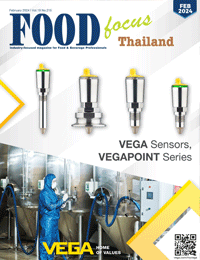การออกแบบตามหลักสุขอนามัยเพื่อประสิทธิภาพในการทำความสะอาดแบบ CIP Hygiene-based Design for Effective CIP
1602 Views |

วรปัญญา สุธานุภาพวุฒิ
Worapanya Suthanupaphwut
Committee of EHEDG Thailand
Regional Section
EHEDG Authorized Trainer
worapanya@gmail.com
การออกแบบตามหลักสุขอนามัยเพื่อการจัดทำระบบ CIP
ในการออกแบบตามหลักสุขอนามัยเพื่อประสิทธิภาพในการทำความสะอาดแบบ CIP จะเน้นไปยังกระบวนการผลิตที่เป็นระบบปิดหรือระบบการผลิตอาหารเหลว โดยอุปกรณ์หลัก ประกอบด้วย ถัง ท่อ ปั๊ม วาล์ว อุปกรณ์แลกเปลี่ยนความร้อน เครื่องฆ่าเชื้อ และเครื่องบรรจุ ซึ่งการออกแบบจะมี 2 ระดับ ได้แก่ ระดับอุปกรณ์เครื่องจักร และระดับกระบวนการ โดยในระดับอุปกรณ์เครื่องจักรจะเริ่มจากชิ้นส่วนที่สร้างขึ้นเฉพาะงาน และชิ้นส่วนหรืออุปกรณ์ที่นำเข้ามาประกอบซึ่งสัมผัสกับอาหารโดยตรงทุกชิ้น นอกจากนี้ ระบบปลอดเชื้อยังรวมไปถึงระบบน้ำและระบบลมอีกด้วย โดยคุณสมบัติสำคัญของอุปกรณ์เครื่องจักร มีดังต่อไปนี้
1. วัสดุที่ใช้จะต้องมีความเหมาะสมกับผลิตภัณฑ์หรือวัตถุในขั้นตอนนั้น และมีความคงทนต่อกระบวนการผลิต ทั้งในด้านความแข็งแรง อุณหภูมิ และความดันที่เกิดขึ้นในการผลิต รวมถึงทนต่อสารเคมีที่ใช้ในการทำความสะอาดและการฆ่าเชื้อ
2. ค่าความหยาบของผิวเฉลี่ยสำหรับวัสดุที่สัมผัสกับอาหารจะต้องไม่เกิน 0.8 ไมครอน (Ra ≤ 0.8 µm) ซึ่งค่าความหยาบของผิวที่สูงกว่าหรือหยาบมากกว่าจะส่งผลให้เกิดการเกาะติดของคราบอาหารและคราบตะกรันได้ง่ายกว่า
3. การออกแบบขึ้นรูป ประกอบ หรือเชื่อมต่อชิ้นส่วนอุปกรณ์เครื่องจักรไม่ให้มีส่วนของพื้นที่หรือช่องที่จะกักเก็บผลิตภัณฑ์หรือสารทำความสะอาด เพื่อให้ผลิตภัณฑ์ที่ส่งมาเก็บหรือไหลผ่านนั้นสามารถระบายออกได้ทั้งหมด
4. ลักษณะรูปทรงของอุปกรณ์เครื่องจักรจะต้องเปิดรับสารทำความสะอาดได้อย่างทั่วถึงทุกพื้นที่ที่สัมผัสกับผลิตภัณฑ์โดยตรงและโดยอ้อม โดยชิ้นส่วนภายในเครื่องจักรจะต้องไม่ปิดกั้นการล้างหรือสารทำความสะอาด
Hygienic Design for CIP System
Hygienic design for enhanced efficiency of clean-in-place system emphasizes the manufacturing process or liquid food processing system. The leading equipment involved in this design usually consists of tanks, pipelines, valves, heat exchangers, sterilizers, and filling machines. The design can be categorized into 2 levels: machinery and operation levels. The first level starts with specific parts designed and produced for particular tasks. Then, other equipment parts or tools are sourced and assembled with the rest of the manufacturing machinery, which has direct contact with food. In addition, aseptic systems, which also include water circulation and ventilation, are also involved. The hygienic equipment must fulfill the following requirements.
1. The materials chosen for the equipment must be compatible with the products or items in that particular process. In terms of durability, they must be sufficiently strong and resistant to temperature, pressure, and chemicals in the production and disinfection processes.
2. The average roughness of the surface of food-contact materials must not exceed 0.8 microns
(Ra ≤ 0.8 µm). Any value higher than that may increase the adhesion of food stain and fouling, further complicating and prolonging the cleaning procedure.
3. The design of the forming, assembly, and welding processes for equipment parts must not create any space or gap where the product or cleaning solution can get trapped and accumulate.
4. Equipment shape must be designed to fully accessible cleaning agents on every surface with direct or indirect contact with the product. The interior parts must not be obstructed from cleaning or cleaning solutions.






